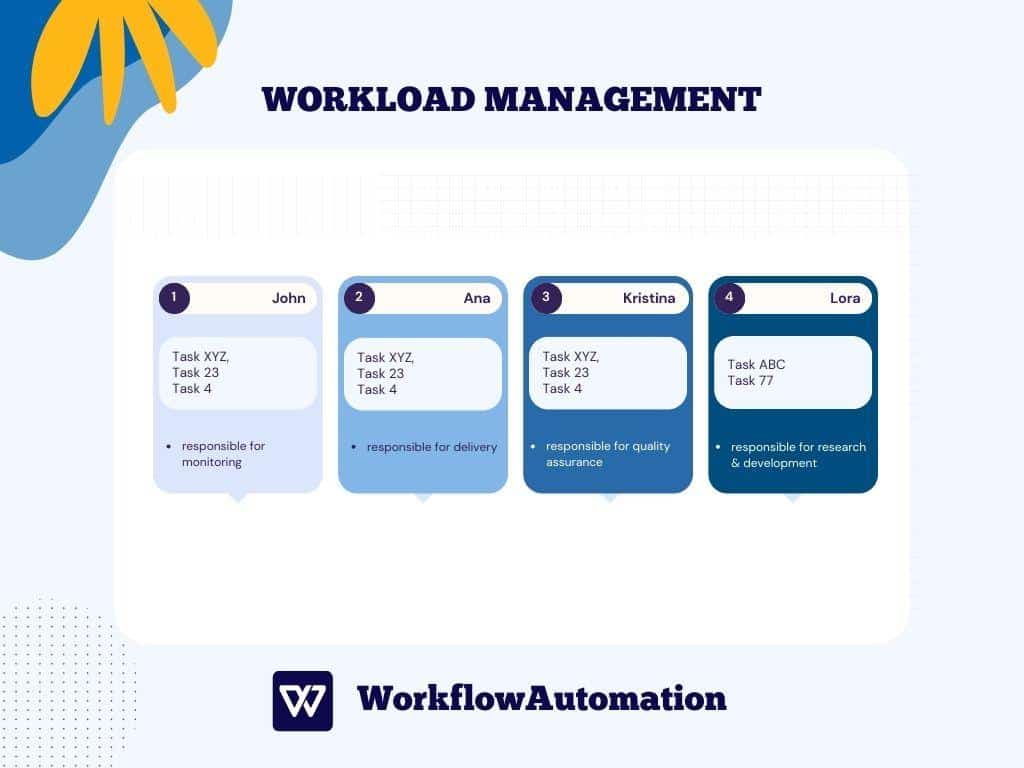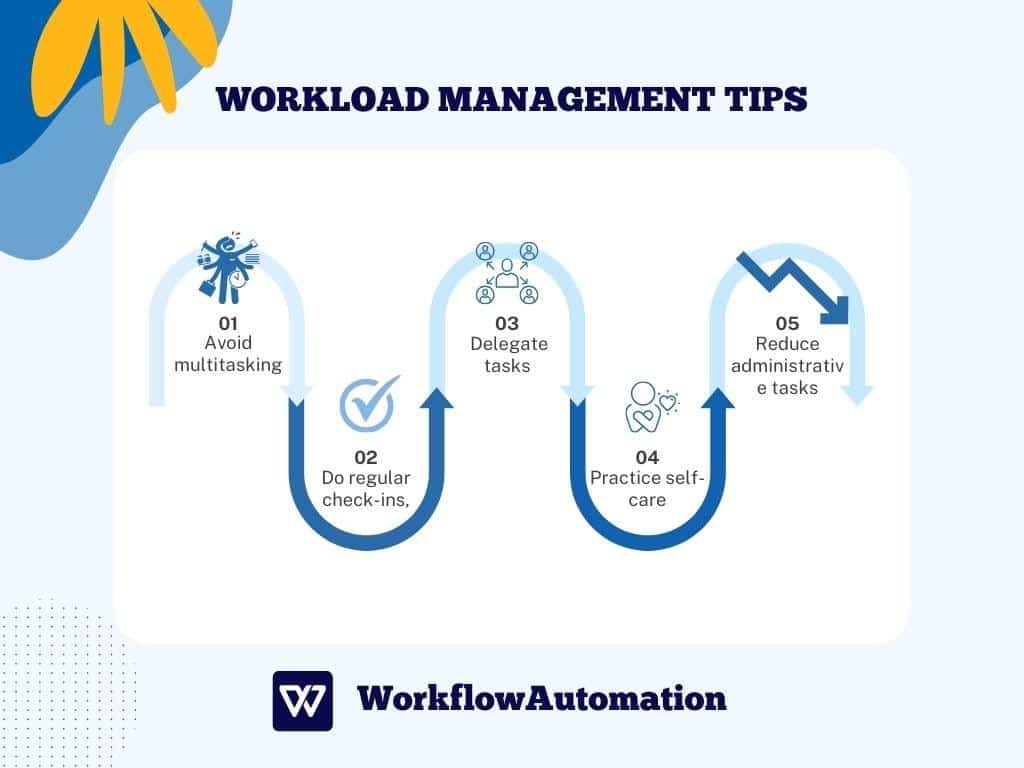In the ever-evolving landscape of the modern business world, where the pace is relentless and expectations are soaring, the art of effective workload management is crucial.
Imagine a workplace where tasks flow seamlessly, where burnout is but a distant memory, and where the workforce operates like a well-oiled machine. This vision is not just utopian but a real possibility, and it begins with mastering the delicate art of workload management.
This article provides insight into workload management, its significance, and tips you can use to successfully enable your team to grow and achieve project goals. Let’s get started!
What is Workload Management?
Workload management is a systematic approach to efficiently planning, scheduling, allocating, and monitoring workload among employees.
Optimal workload distribution means employees will not be overwhelmed with work and will not have more duties than they’re required to. It is not an easy task, but with a systematic approach, you’ll be on the right path to successful workload management.
To achieve successful workload allocation, a project manager needs the following management skills:
- Prioritization
- Time management
- Task delegation
- Team communication
- Stress management
Workload management is applied regardless of team size or industry since it directly affects employee satisfaction and company results.
The Importance of Workload Management
Workload management is crucial in maintaining productivity, promoting fairness, and preventing burnout. By implementing effective workload management strategies, individuals and teams can distribute tasks fairly, avoid excessive workloads, and achieve better work-life balance.
Let’s delve deeper into the importance of workload management and its key benefits.
It Distributes The Tasks Fairly
Workload management ensures the fair distribution of tasks, creating an environment where each individual feels valued and respected. By considering task complexity, quantity, individual expertise, availability, and team dynamics, workload management facilitates equitable task allocation.
This approach promotes collaboration, fosters a sense of ownership, and establishes a healthy working dynamic among team members.
It Prevents Burnout
Prioritizing employee well-being is a fundamental aspect of workload management. Overloading employees with excessive work or consistently assigning mentally demanding tasks can lead to burnout.
Through workload management, leaders can ensure that workloads remain reasonable and sustainable, allowing employees to maintain motivation, engagement, and overall performance.
It Helps With Project Scheduling
Managers can create realistic project timelines by objectively assessing task complexity and considering employee capacities. That enables effective resource management, ensuring the right assignment of tasks to the right individuals at the appropriate time.
It Maintains Workflow Efficiency
An effective workload management strategy prevents bottlenecks by equally distributing tasks among team members. By assigning tasks based on individual capacities and skill sets, workload management optimizes workflow efficiency.
This balanced distribution of responsibilities allows interconnected processes to flow smoothly, eliminating delays and improving overall project execution.
It Allows for Effective Time Management
Individuals can allocate their time and energy efficiently by prioritizing tasks based on their importance and urgency using workload management. This approach prevents individuals from being overwhelmed by less critical tasks and allows them to focus on key responsibilities.
How to Create a Workload Management Process
Workload management can be demanding since it requires the skills we mentioned, empathy, and an understanding of the structure and needs of each team member and team as a whole.
To help you develop one with no hassle, we have prepared a step-by-step process guide for successful workload management creation:
#1. Identify All the Projects
The first step in creating a workload management process is to identify and map out all the projects within the organization, which includes both ongoing and upcoming projects.
When you have a clear overview of the projects, you can better understand the scope of work and resource requirements for each. Consider creating a project inventory or using project management software to document and track the projects.
#2. Break Down Projects Into Tasks
Once the projects are identified, it is important to break them down into smaller tasks. Task breakdown helps understand the specific actions required to complete each project and facilitates effective resource allocation.
Collaborate with the project team to identify the individual tasks and create a task list for each project. This can be done using project management tools or simple spreadsheets.
#3. Analyze Team Capacity
It is crucial to analyze the capacity and availability of the team members. Assess their skills, experience, and workload to determine how much work they can handle at a given time.
Understanding the team’s capacity allows you to allocate tasks appropriately and avoid overloading individuals or leaving resources underutilized. Consider creating a team member skills and availability map, which can help to identify skill gaps and ensure the right people are assigned to the right tasks.
#4. Assign the Tasks
Assign the tasks to the appropriate team members based on the team’s capacity and members’ skills. Consider their workload, expertise, experience, and development opportunities when distributing tasks.
Distributing tasks fairly and evenly among the team members promotes collaboration, minimizes potential errors, and ensures optimal resource utilization. For example, if a team member has extensive experience in user interface design, assign them tasks related to that area.
#5. Monitor Progress
Monitoring progress is a very important step since it helps identify potential issues, track project timelines, and make necessary adjustments to optimize workload management. Use project management tools to track task completion, provide updates, and foster effective communication within the team.
It is also important to encourage team members to provide regular reports and hold periodic team meetings to discuss any challenges or roadblocks. This allows for proactive problem-solving and ensures the project stays on track.
10 Tips for Managing Workload Effectively
To address the challenges of workload management effectively and ensure the well-being and productivity of everyone involved, knowing how to manage the workload of employees is essential. Here are some tips to help you manage the workload perfectly:
#1. Implement Time-Tracking Software
Implementing time-tracking software allows you to monitor the work engagement of your employees. It provides insights into their productivity levels and helps identify any challenges they may face in task execution.
By tracking the time spent on tasks, you can recognize if someone is overloaded and use that information to distribute work better. Time tracking software is also a valuable tool for employees, enabling them to monitor their work, better organize their tasks, and prioritize effectively.
#2. Avoid Multitasking
Minimize multitasking whenever possible. Although it can seem tempting to juggle multiple tasks simultaneously to save time, it often results in reduced productivity and increased errors.
Multitasking divides your focus and compromises your attention to detail. Therefore, prioritize your tasks, focus on one task at a time, and give it your full attention for better quality results.
#3. Be Mindful of Sick Days & Vacation
When planning your workload, it’s essential to consider sick days and vacation time. Include these absences in your project timeline and workload distribution.
Plan tasks in a way that allows for flexibility and ensures work can continue smoothly even when team members are absent. By taking into account time off, you minimize disruptions and maintain productivity within the team.
#4. Do Regular Check-Ins With the Team
Schedule meetings or brief check-ins to discuss ongoing projects, task progress, and potential challenges. These check-ins foster open communication, allowing team members to share updates, ask for help, and collaborate on finding solutions.
Regular check-ins also help managers identify potential bottlenecks or workload imbalances, enabling them to make necessary adjustments to ensure a balanced workload distribution.
#5. Prioritize Tasks Continuously
Regularly assess the urgency and importance of each task and adjust your priorities accordingly. Identify critical tasks and focus on completing them first. Break down larger projects into smaller, manageable tasks and allocate time and resources accordingly. Review and reassess your task list to ensure you always work on what matters most.
#6. Delegate and Collaborate
When delegating tasks, it is important to carefully consider the nature of the duties and assign them to the appropriate individuals rather than doing so haphazardly.
You can always consider assigning demanding tasks to a capable team and encourage team members to collaborate as well. This way, you’ll benefit from faster task completion and increased effectiveness.
#7. Practice Self-Care
Always prioritize your well-being and self-care while carrying out your work responsibilities. Recognize that being well-rested and regularly renewing your energy will allow you to contribute more and deliver higher-quality results.
Avoid becoming trapped in work and overly dedicated, as it can have a counterproductive effect. While it may not be immediately evident, neglecting self-care can lead to dissatisfaction, increased stress levels, and reduced performance over time.
#8. Reduce Administrative Tasks
One way to manage the workload of employees is by reducing administrative tasks. Pay attention to the tasks your employees regularly perform and assess their significance in relation to overall operations.
Identify repetitive tasks that require minimal mental effort but can be time-consuming and physically draining. These tasks, if not essential, can be streamlined or automated to free up employees’ time and energy for more impactful work, and that can be done with the help of a workflow engine.
#9. Set Achievable Deadlines
If your employees consistently struggle to meet unrealistic deadlines despite their efforts, it can erode their self-confidence, motivation, and dedication. It is more beneficial to consistently progress step by step rather than remaining stagnant.
So, avoid creating stressful situations that exhaust your employees by setting excessively short deadlines. Instead, focus on good organization, open communication, team collaboration, marker observation, and adaptability.
#10. Embrace Agile Work Methodologies
Consider adopting Agile methodology and its frameworks, such as Kanban or Scrum, to enhance workload management. These frameworks promote flexibility, transparency, and collaboration within teams.
Agile methodology involves breaking down projects into smaller, manageable tasks called “sprints” or “cards” and setting short-term goals for each. Regular team meetings, known as “standups” or “scrums”, allow for quick progress updates and issue resolution.
By implementing agile practices, you can better adapt to changing priorities, allocate work efficiently, and maintain a steady workflow, ensuring that you consistently meet project milestones and deliver high-quality results.
Common Workload Management Challenges
In the previous section, we discussed the importance of effective workload management and provided improvement tips.
In this section, we will delve into some key reasons that hinder effective workload management and explore strategies to address them to create a positive work atmosphere and achieve successful outcomes.
#1. Uneven Workload Distribution
Uneven workload distribution is a common problem in organizations, where some individuals or teams are overwhelmed with work while others have lighter workloads. This leads to stress, exhaustion, and burnout for some employees and creates a sense of inequity and discord among individuals and teams.
So, have a comprehensive understanding of the workload’s complexity and volume, as well as the availability and capacity of your employees. By carefully evaluating these factors, you can ensure a fair and balanced distribution of tasks.
Encourage open communication and collaboration among team members to identify workload imbalances and make necessary adjustments.
#2. Unrealistic Expectations
Setting unrealistic expectations can significantly impact employee motivation and performance. Realistic expectations often arise when goals need to be aligned with deadlines with available resources, time constraints, or the complexity of tasks.
Therefore, set realistic goals and communicate them effectively to project stakeholders. Regularly assess and adjust expectations based on available resources and prioritize tasks accordingly. Open and transparent communication is key to managing expectations and negotiating realistic timelines when necessary.
#3. Demanding Work Culture
A demanding work culture characterized by long working hours, constant pressure, and a lack of work-life balance can significantly impact workload management. This work environment often increases stress levels, reduces motivation, and decreases productivity.
It would help if you created a supportive work culture that values work-life balance, employee well-being, and open communication. Encourage employees to take breaks, utilize vacation time, and prioritize self-care. Foster a culture that promotes collaboration, teamwork, and mutual support among colleagues.
#4. Lack of Capacity/Resources
When teams are understaffed or lack the necessary resources to handle their workload, it increases pressure and reduces productivity. Therefore, regularly assess resource needs and ensure adequate staffing levels to alleviate this issue. Consider outsourcing certain tasks or seeking additional resources when necessary.
#5. Being a Perfectionist
Striving for excellence in your work is commendable, but being a perfectionist can hinder effective workload management. The desire for perfection can lead to excessive time spent on tasks, which may result in delays and increased pressure.
Finding a balance between high-quality work and efficient task completion is crucial. Focus on delivering high-quality outcomes while remembering that perfection is only sometimes attainable within time constraints.
#6. Not Being Able to Concentrate and Maintain Focus
External factors, such as a noisy work environment or constant interruptions, as well as internal factors, such as poor organization or lack of sleep, can impact concentration and affect workload management.
To address this challenge, create a peaceful work environment, minimize distractions, and utilize productivity hacks and techniques to enhance focus and concentration. You can employ productivity techniques, such as time blocking or the Pomodoro techniques, to enhance concentration and task completion.
#7. Inadequate Time Management Skills
Employees who struggle with time management may find themselves overwhelmed by tasks and deadlines. Offer time management training and resources to help employees improve their organizational skills.
Encourage the use of time management tools and techniques, such as to-do lists, calendars, and prioritization methods, to enhance their ability to manage their workload effectively.
#8. Lack of Clear Prioritization
Without clear prioritization, employees may struggle to determine which tasks are most important and need immediate attention. This can lead to a scattered approach to work and missed deadlines.
Encourage individuals and teams to establish clear prioritization criteria based on factors like urgency, impact, and alignment with strategic goals. Implement a system for setting and regularly reviewing priorities to ensure that everyone is focused on the most critical tasks and projects.
Conclusion
Fostering a healthy work environment and a positive atmosphere ensures consistent success and positive results. The dedication and commitment of your team to their responsibilities greatly rely on how superiors and the organization treat them.
By implementing workload management strategies, allocating resources effectively, setting realistic goals, and promoting collaboration and self-care, you will cultivate a community of valuable and hardworking individuals, driving the growth and success of your organization.







